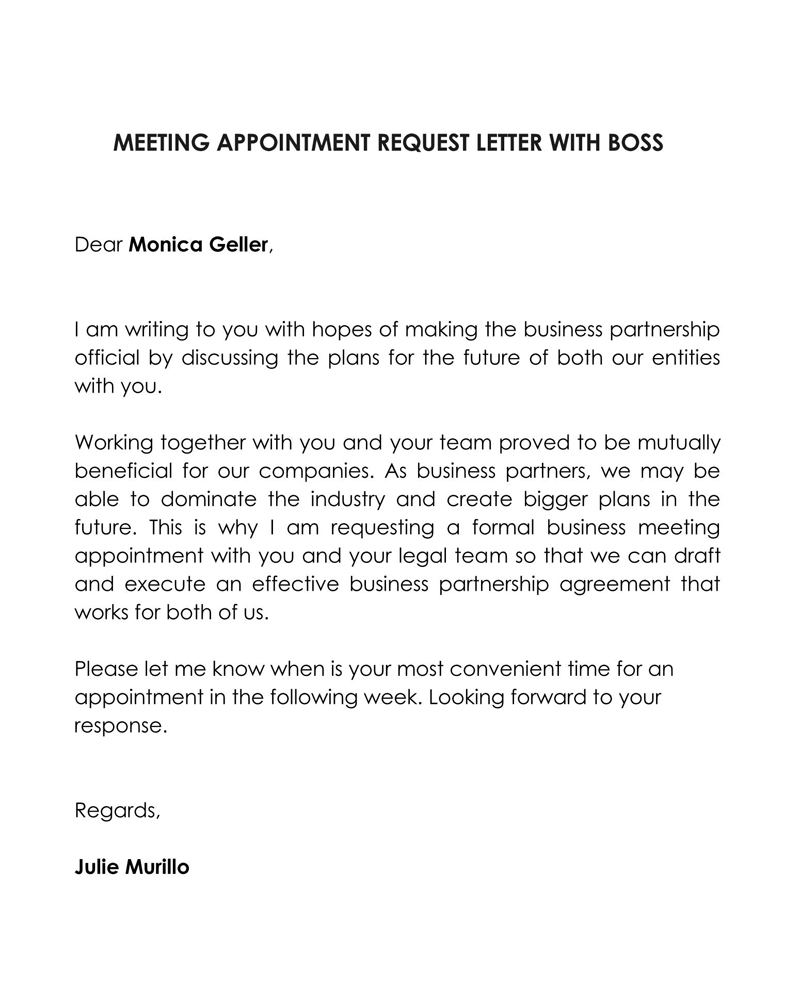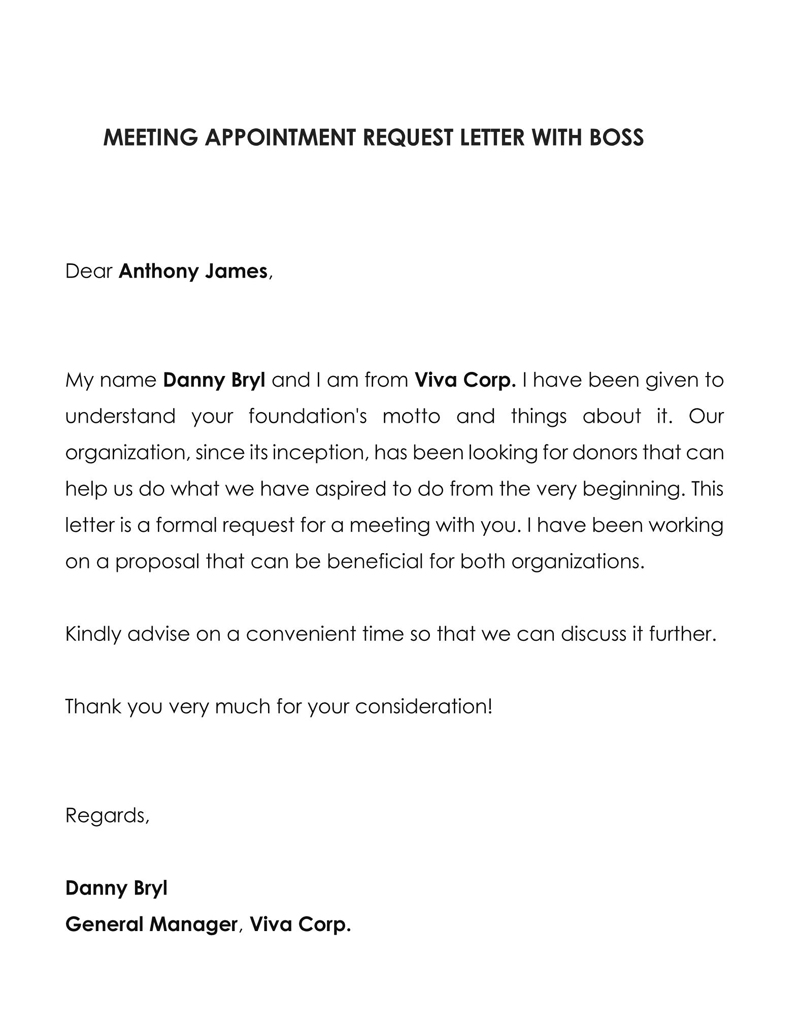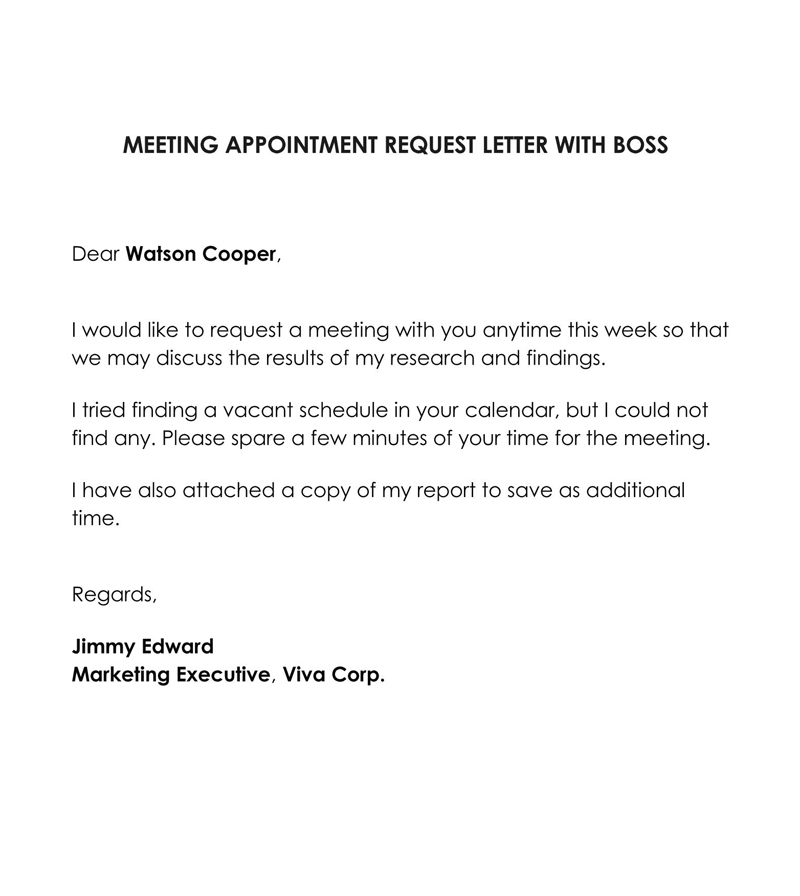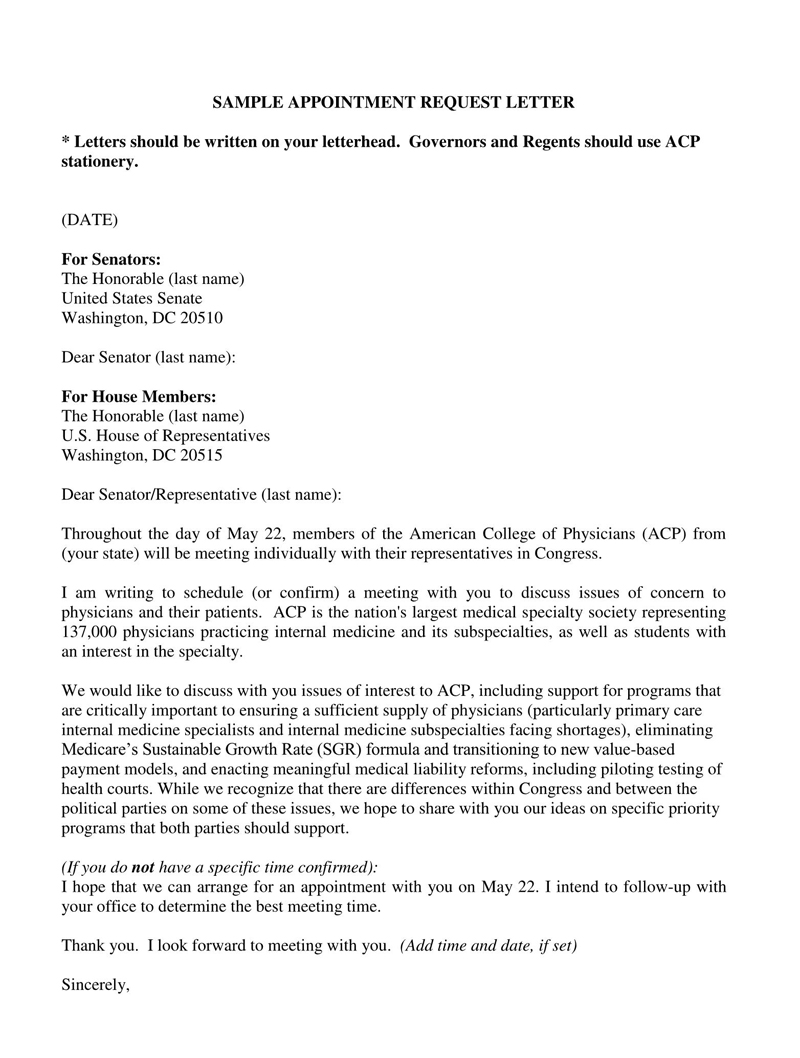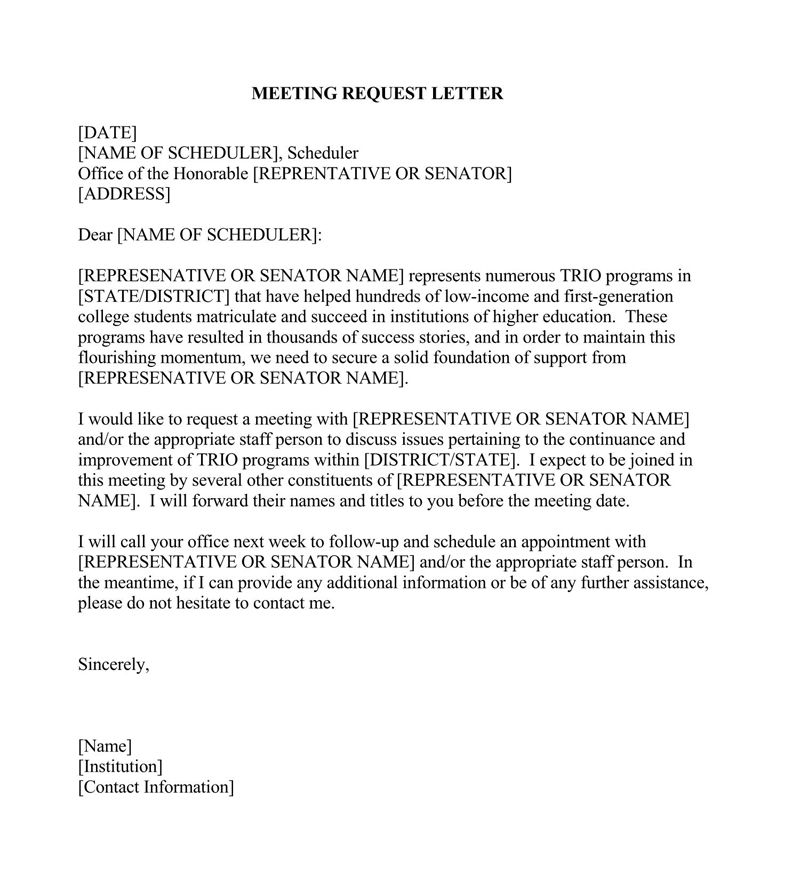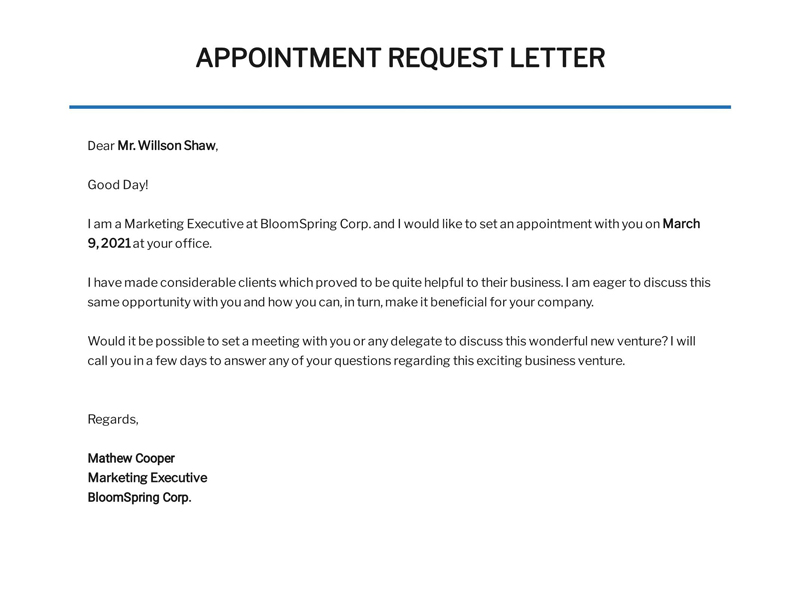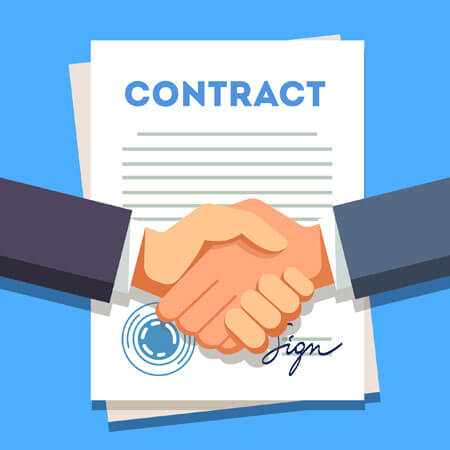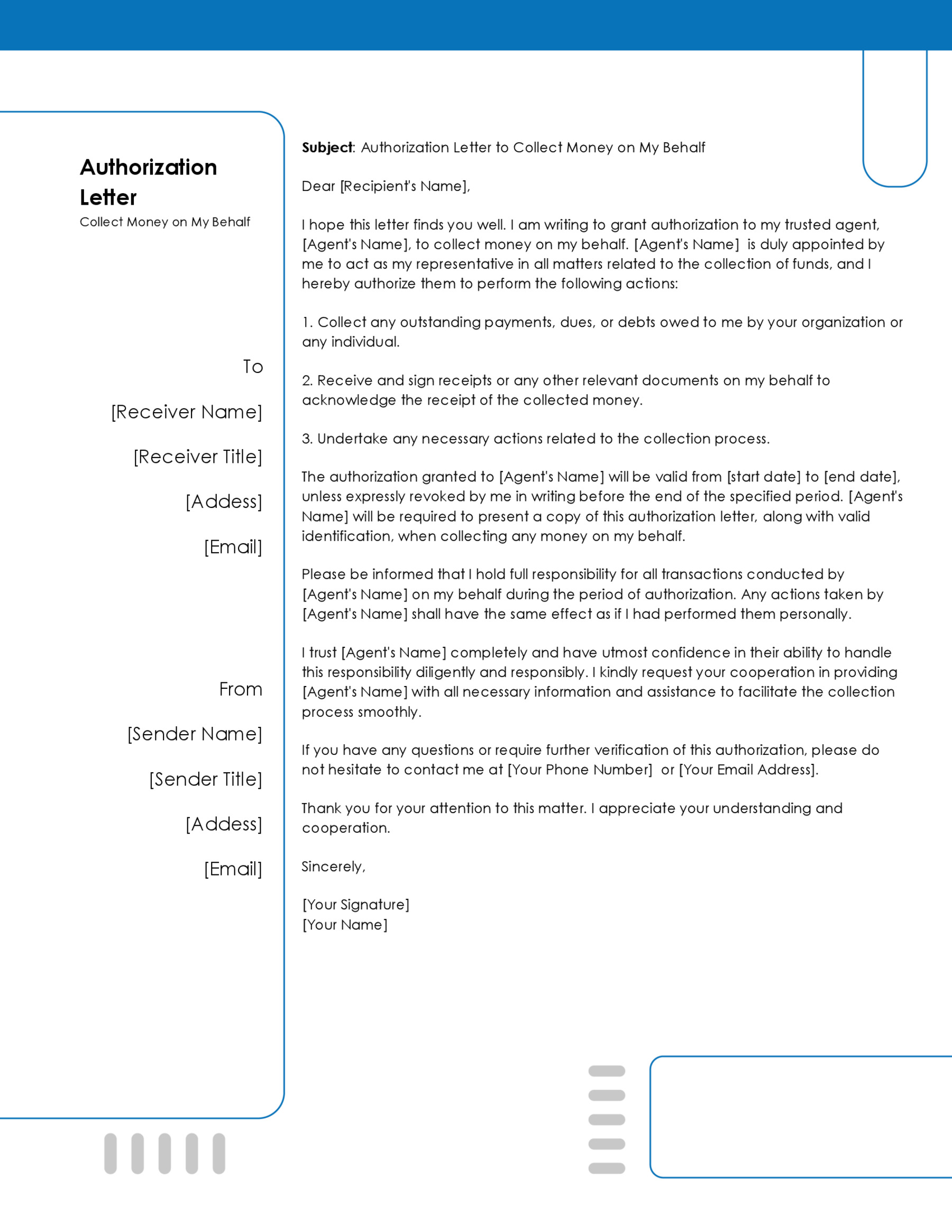A request letter for a meeting appointment with the boss is an official written request by an employee for an appointment with their senior to discuss an issue in detail. The letter will typically be addressed to a specific recipient in charge of the domain under which the issue at hand befalls.
Communication is a major contributor to effective management and task execution at the workplace. The letter is one of the effective tools used to ensure that communication is established between employees and their superiors.
EXAMPLE
If you want to discuss how budget cuts have negatively affected production, salary increase issues, a marketing idea, or any other issue with your superior, you can write a formal letter requesting a meeting appointment with your boss.
The letter will increase your chances of getting an appointment to share your thoughts.The letter can be used by any employee who wants to discuss something important with their boss. More often than not, the letter is sent via email. Considering its application at the workplace, it has to be formally formatted. It should declare why you need the appointment and suggestions for the requested meeting’s time, place, and duration.
Sample Letters
Employees can use sample request letters whenever they want to ask for a meeting appointment with their boss. The templates are designed to outline all the fundamental components of the letter and prompt users to input this information for requesting an appointment with their boss. You can download and personalize them to befit your situation.
Why You Should Send a Letter or Email Instead of a Verbal Request
Employees can always choose to request an appointment with their boss, either in person or via a written request. Walking up to their office and asking for a meeting may often be limiting as it gives the boss no preparation time, and you might end up getting little appointment time.
On the other hand, written requests are considered more professional. Sending the letter for the appointment via post or email creates a reference source for scheduling details, unlike a verbal request. This way, even if the meeting is scheduled on a distant date, you can confirm the time, location, and reason from the letter.
Unlike a verbal request, a written request also allows you to easily transfer scheduling information to a time management app, calendar, or journal from your computer or mobile phone.
Pre-Writing Considerations
Whenever you request a meeting appointment with your boss, it is crucial to get all information correct. This will typically require adequate preparation before writing the letter. There are different pre-writing considerations you should take into account depending on your reason for seeking an appointment with your superior.
These considerations are as follows:
For sharing a new idea/pitch
Employees can request an appointment with their boss to pitch a new idea for improving operations within the company or organization. If this is the case, the employee has to review the proposal and collect supporting data to persuade their boss. This involves going through research reports and preparing summary reports and presentations, which can be forwarded to the boss in advance. With such information at hand, note down the key points of the pitch such as benefits, projections, and risk analysis results, and mention them briefly in the letter.
For issuing a complaint
Filing a complaint is another reason why an employee can be prompted to write a letter. Complaints are taken seriously at the workplace. However, they must be justified. To ensure your complaint is justified enough for your boss to agree to a meeting, you need to have the facts in order before writing the letter. This includes gathering evidence of the issue at hand, accurate dates, words and acts you want to bring to the boss’s attention. Create a complete background/history of the problem and pick the key points so that you can mention them in the letter briefly.
For making an announcement
The letter can be written when announcing to the boss about emerging issues such as a staff meeting to which you would like to invite them and when submitting progress reports on an ongoing project. In such a situation, try to compile the key discussion points you would like to inform them about and ask for an appointment to discuss them further.
For announcing your resignation
This letter is the first step of the resignation process. Ordinarily, an in-person meeting is needed before a resignation letter is written. Before writing, ensure that you have a resignation date in mind, necessary documents, and proposals on how to handle the transition. Then, align your letter to these details.
How to Write a Request Letter for Meeting Appointment with the Boss
The letter will often be one of the protocols for requesting an appointment with senior employees and key figures in the company. Therefore, the letter must be objective to save the recipient time when reviewing, considering the multiple letters they have to review. This article will look into the process of writing a request letter that captures all the essential components of an official request to your boss.
The steps involved in the writing process are as follows:
Add a header
Firstly, provide a header that captures the date and the recipient’s information. Note that the letter is formal and therefore has to be structured as such.
Mention the following details:
Date
Insert the date when the letter was written. Formal documents have to be dated for filing and reference purposes. Ensure to mention the day, month, and year.
EXAMPLE
January 05, 20xx
Receiver’s details
Next, identify the recipient of the letter (your boss). Indicate their name, position, company name, and appropriate address.
EXAMPLE
John Doe,
Managing Director,
BridgeInn Travels Ltd,
44 Lee Shore Street,
Chelsea, VA 2071
And if you are writing an email, you will add a subject line.
EXAMPLE
Subject: John Hill requests for a meeting; kindly reply with the appropriate meeting time, or request to schedule an appointment.
note
The letter should also have a captivating subject line that persuades the recipient to read the letter. Ensure the subject line indicates the purpose of the letter by having the term meeting, schedule, or appointment. The subject line can be detailed if the letter is being sent to a recipient who is not expecting it.
Write salutation
After the subject line, provide an appropriate salutation. A formal salutation will include the recipient’s title and name: Dear Mr/Ms/Mrs followed by their last name, for instance, Smith. The salutation can also include the recipient’s first and last name.
EXAMPLE
Dear Mr John Doe. In addition, it can incorporate appropriate titles such as Dr (doctor) and Eng. (engineer). If the letter is being sent to more than one recipient, the salutation can appropriately categorize the recipients, for example, To the Sales Team or Dear HR Department Officers.
Introduction
Once a formal salutation has been provided, provide a brief but organized introduction. Introductions are often necessary, especially in large companies where the recipient deals with multiple employees or when the recipient isn’t aware you are sending the letter or does not know you.
Your introduction should go directly to the point by discussing the following:
Briefly introduce yourself
Start the introduction by providing your name and one or two details such as your job designation or a previous encounter that would help them identify you.
EXAMPLE
I am Brad Milik, a software engineer from the Research and Development Department. I’ve been working on a program for more than one year, and I strongly believe it is ready for implementation.
State a reason for the meeting
The introduction should also briefly state the reason you are sending the letter. Be specific and let them know the importance or urgency of the meeting.
EXAMPLE
I want to discuss a new model of signing up customers and recommending our services to them more effectively.
Body
Now that the reader has been briefed on what you want to discuss in the letter, you can delve into details about your proposed meeting.
Discuss the following details:
Suggest a place, date, and time
Firstly, brainstorm on the likely suitable locations and dates when the recipient would not object to meeting you. Choose dates and times when they are more likely to be less busy and suggest the least busy date and time. This may require some research on the recipient’s schedule. Next, choose a suitable location like their office for instance, and suggest holding the meeting there. List a few options and let them choose what works for them.
EXAMPLE
In this regard, I’d like to have an in-person meeting with you. Allow me to suggest meeting at your office. I can come in any day between Wednesday and Friday from 11:00 AM to 13:00.
Suggest an estimated meeting duration
Most senior employees will usually have busy schedules and value their time. Suggest a reasonable duration for the meeting. The duration can be determined based on what you want to discuss and how much available time the recipient has.
EXAMPLE
I kindly request 30-40 minutes to give you a comprehensive overview of my proposal.
Benefits of the meeting
Next, outline the benefits of holding the meeting. A meeting will usually be worth their time if they can be convinced that it is for the company’s betterment. Mention a few benefits and leave in-depth explanations for the actual meeting.
EXAMPLE
This meeting is meant to give you an overview of how the program works and how BridgeInn Travels can benefit from my innovation.
Closing
Finally, to conclude the letter, discuss the following essential components:
Request a follow-up
Always ask for confirmation that they read the letter and are willing to give you an appointment. This ensures that the recipient can get back to you at the time that best suits them from what you suggested.
EXAMPLE
Kindly confirm which date, time, and location would be most suitable for you.
Provide your contact details
You should also leave your contact information which they can use to reach out to you. You can include a phone number or email address. Either of the two will work for most employers.
EXAMPLE
You can contact me anytime on my phone number 441 2054 5392 0021.
Sign off
Finalize the letter by signing off. Provide a complimentary close with your name and position. For mailed letters, also provide a signature.
EXAMPLE
Yours Sincerely,
Brad Milik
Software Engineer
Template and Sample
template
[Date]
[Name of recipient]
[Position]
[Company Name]
[Address]
[City, State, ZIP]
[Subject]
[Salutation]
I am [your name], [job title] at [company name]. I’d like to request a meeting regarding [reason for appointment].
I’m kindly requesting the meeting be held [date, time, and place] or latest at the end of next week as a result of the urgency of the matter. I’d like to discuss [items of discussion] during the meeting. Therefore, a meeting of [duration of meeting] will be sufficient to take you through the matter at hand.
I’d be appreciative if you could get back to me with confirmation through my email [your email] or [phone number].
Sincerely,
[Signature]
[Your Name]
[Job Title]
Sample Letters
Effective communication in the workplace often involves formally requesting a meeting with your superior. Access the sample letter below to ensure your request is articulate, respectful, and professional.
sample
Dear Mr. Smith,
I hope this letter finds you well. I am writing to request a meeting to discuss the recent developments in our project, “Innovate 2025”, and the potential impact these might have on our timeline and deliverables. As you are aware, this project is crucial for our team and has the potential to set a new benchmark for our company, Excellence Innovations Inc.
In the past week, there have been significant updates from our key suppliers, especially from TechnoMaterials Ltd., which suggest a possible delay in the shipment of critical components. This situation necessitates a revision of our project plan and a discussion on how to mitigate any potential risks. I believe your insights and experience would be invaluable in navigating this challenge effectively.
I am flexible regarding the time and date of the meeting and will accommodate your schedule. I am confident that with your guidance, we can ensure the continued success of our project without compromising on quality or deadlines. Thank you for considering my request. I look forward to your response and the opportunity to discuss this matter in detail.
Sincerely,
John Jacobs
Senior Project Manager
Excellence Innovations Inc.
Analysis
The provided sample letter is an effective example for someone looking to write a formal request for a meeting with their boss due to several key elements. Firstly, the tone of the letter is professional and respectful, which is crucial in a workplace setting. This is achieved through polite language and a formal salutation. Secondly, the writer clearly states the purpose of the letter in the opening paragraph, which is to discuss recent developments in a project. This direct approach ensures the reader understands the letter’s intent right away. The inclusion of specific details, like the project name “Innovate 2025” and the supplier “TechnoMaterials Ltd.,” adds a sense of urgency and relevance to the request.
Additionally, the writer acknowledges the boss’s expertise and role, which not only shows respect but also underscores the importance of the meeting. The flexibility in scheduling offered by the writer demonstrates consideration for the boss’s time, which is a thoughtful and professional gesture.
Lastly, the closing of the letter is formal and includes the writer’s name and position, reinforcing their role and the context of the request. Overall, these elements combine to create a well-structured and effective request letter.
Special Considerations
In order to write an effective letter, there are various writing techniques employees can implement.
Some of these writing tips are discussed below:
Be specific
Always keep the letter brief and direct. Discuss what is necessary to let the recipient know why you want a meeting and convince them to agree to the meeting. One page will typically be enough to capture this information.
Be professional and respectful
Ensure the letter remains professional and polite throughout. Address your boss appropriately and make sure that the letter sounds like an appointment request rather than a demand. Professionalism and politeness increase your chances of getting the meeting.
Keep it simple
Keep the letter simple by providing only the necessary information using simple wording. Even if you want to discuss a technical matter with them, avoid using technical jargon.
Proofread
Always review the letter before sending it to the recipient. Ensure it is spelling, grammar, and typo-free. Also, ensure the letter is written in a business format.
Send a reminder
Once the meeting has been set, remind the recipient using a reminder one or two days prior to the meeting. State the date, time, and place in the reminder. Sending such a reminder is also necessary when scheduling between two people
EXAMPLE
Your boss and another departmental head. Ensure to send the reminder to each party. If they decline the request, always suggest a different time and location.
However, if they do not respond to your request, follow up with a phone call; there is always a possibility they never received your request.
Final Thoughts
It can be intimidating whenever an employee wants to discuss something with their boss, especially when they cannot quite find a way to get the boss to agree to a meeting. However, a request letter for a meeting appointment with the boss is an effective tool that can be used in such situations.The employee writes the letter to detail the reason for the meeting, suggestions on when and where to hold the meeting, and persuade the boss that the meeting is worth their time. The letter should be crafted in a business format and must be brief, direct, and error-free.
